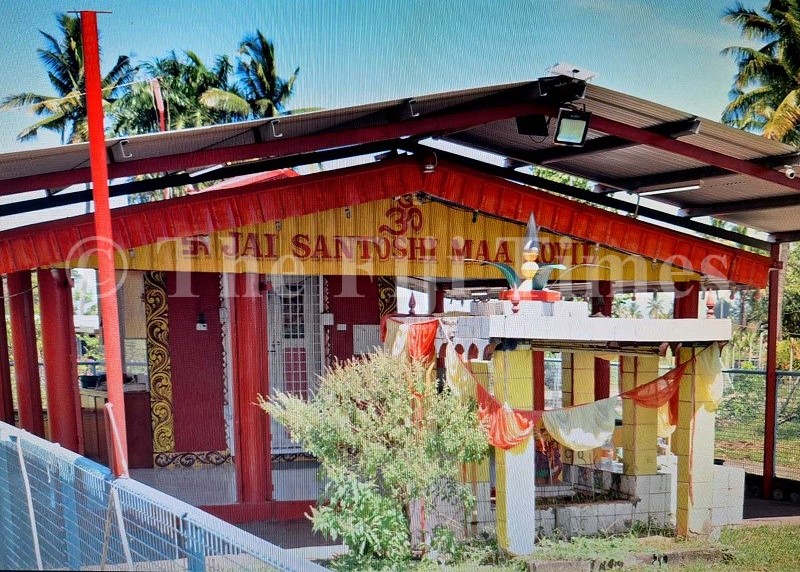Jai Santoshi Maa Temple started from humble beginnings 47 years ago on BS Charan Rd at Lovu, Lautoka.
Its founder Jan Mohammed was an ardent devotee of the goddess and back in the day, the temple was also commonly known as Jan Mandir.
According to temple pujari (priest) Vijay Kumar, the initial temple was just across the road from its current site.
“Our founder’s guru, Mr Golenkanna, played an instrumental role in the establishment of the temple, and once it was constructed, it was inaugurated with a prayer followed by the South Indian firewalking ceremony,” Pujari Kumar said, adding he’s been associated with the temple since its inception and a witness to its growth over the years.
“I was around 15 years of age when our temple was inaugurated and I have learnt everything in terms of conducting all the prayer rituals from our founder.”
Pujari Kumar said since 1984, he’s conducted the annual fire-walking ceremony as well. “Even when our founder was alive, I had started learning the ropes of all the temple’s activities.”
Pujari Kumar said that in 2005, the construction of a new Jai Santoshi Maa Temple was initiated just a few meters away from the original temple.
“Unfortunately, our founder could not see it through to completion because he passed away in 2006, however, we took the reins of the temple and our new temple was completed the same year.”
Pujari Kumar said another priest, Kamlesh Shankaran Nair, has been assisting him with daily temple prayers and other temple activities.
“We usually do all the Hindu pooja ceremonies at our temple, the Ram Navami, Maha Shivratri, Navratri, Krishna Janmastami, Ganga Pooja and our annual fire-walking pooja (Mariamman puja).”
Pujari Kumar said the Mariamman pooja is a five-day session of continuous ritual when devotees taking part in the fire-walking ceremony abstain from drinking alcohol, eating meat, smoking cigarettes and engaging in sexual intercourse at least 14 to 21 days prior to the main event, which is usually during the Easter holidays.
“The Mariamman pooja usually starts on a Wednesday and from that day onwards until the prayers are completed, the devotees taking part in the prayer ceremony should not leave the temple premises to maintain the ritual sanctity.”
A kangan (bangle) is tied to the wrists of all devotees’ who are then whipped lightly by the pujaris. All devotees must wear a yellow sulu and shirt and chant Govinda at all times.
He said that on the Wednesday afternoon, there is a flag-raising ceremony for the commencement of the pooja.
“After that there is an assembly of Gargam that takes place near the river and then the Gargam procession arrives at the temple. On Thursday, the Gargam procession leaves the temple for the late Ram Sami Rd, Navoka Settlement, Lovu Seaside, Naikabula, Field 40 Rd and then arrives where the Sapram will be. The Sapram and the Gargam arrive at the temple accompanied by Indian musical instruments such as the dapla, flute, dholak and harmonium.
“The fire pit is lit on the same night with the usual kirtan that is sung throughout the night called the Jagran Night.
“On Friday, a hawan ceremony is done before the Gargam procession leaves the temple to Buabua Rd and Vatamai Rd before the Gargam and Sapram arrive at the temple.
“On Saturday, the Gargam procession leaves for Ratu Vereba settlement and then arrives at the temple.”
Pujari Kumar said the temple is decorated with devotees changing into the clothes of Mata Draupadi.
“In the afternoon, the Gargam procession leaves the temple for Vitogo Rd, Lomolomo, Johnson, to Lautoka City Area –town, Indus Place, Yalandi St and then back to the temple.
“The most anticipated Tirikutu dance performance starts at 8pm and finishes early in the morning.”
The priest first walks into the fire pit followed by the devotees, who walk through it thrice. Once completed, the devotees go to the river to dismantle the Gargam and do the Shanti Paath.
The Kulu pooja is done on the following Tuesday where the fire pit is cooled down by covering it with soil.



